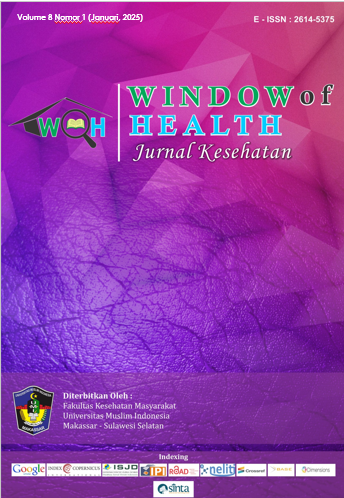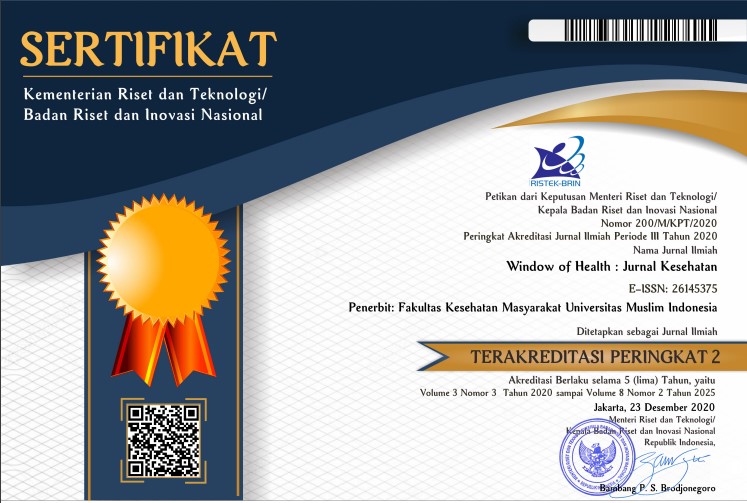Exploration of Strategies to Overcome Dual-Triple Burden of Malnutrition in Adolescent Girls Based on Local Wisdom: A Qualitative Study
Abstract
The dual-triple burden of malnutrition among adolescent girls in Indonesia is a significant issue, particularly in West Sulawesi Province. Majene Regency has the second highest prevalence of malnutrition in the country, with alarming statistics showing that adolescent girls are affected by stunting (31.5%), anemia (17.9%), Chronic Energy Deficiency (KEK) (22.4%), and obesity (18.9%). This study aims to explore strategies for preventing and managing malnutrition based on local wisdom and cultural practices. The methodology includes qualitative-descriptive research through Focus Group Discussions (FGDs) and in-depth interviews with informants from four secondary schools in Majene District. Key informants include health service heads, nutrition officers, school principals, teachers, food vendors, parents, and female students. Their insights provide a comprehensive view of the challenges and potential solutions. The findings indicate several effective strategies: (1) changing mindsets about instant foods through education; (2) promoting healthy eating and local food consumption; (3) regular distribution of iron supplements in schools; (4) encouraging physical activity; (5) innovating healthy food services in school canteens; (6) revitalizing local government programs; and (7) securing funding through School Operational Assistance and Village funds to support these initiatives. In conclusion, there are several local wisdom-based strategies that can be implemented to address malnutrition among adolescent girls. It is suggested that the results of this research can be a valuable reference for local governments, educators, and various stakeholders who are committed to improving the nutritional-health status of adolescent girls.
References
Wrottesley S V., Mates E, Brennan E, Bijalwan V, Menezes R, Ray S, et al. Nutritional status of school-age children and adolescents in low- and middle-income countries across seven global regions: a synthesis of scoping reviews. Public Health Nutr. 2022;26(1):63–95.
Shinde S, Harling G, Assefa N, Bärnighausen T, Bukenya J, Chukwu A, et al. Counting adolescents in: the development of an adolescent health indicator framework for population-based settings. eClinicalMedicine [Internet]. 2023;61(July):1–14. Available from: https://doi.org/10.1016/j.eclinm.2023.102067
Wells JC, Sawaya AL, Wibaek R, Mwangome M, Poullas MS, Yajnik CS, et al. The double burden of malnutrition: aetiological pathways and consequences for health. Lancet. 2020;395(10217):75–88.
Neufeld LM, Andrade EB, Ballonoff Suleiman A, Barker M, Beal T, Blum LS, et al. Food choice in transition: adolescent autonomy, agency, and the food environment. Lancet. 2022;399(10320):185–97.
Black MM, Lutter CK, Trude ACB. All children surviving and thriving: re-envisioning UNICEF’s conceptual framework of malnutrition. Lancet Glob Heal [Internet]. 2020;8(6):e766–7. Available from: http://dx.doi.org/10.1016/S2214-109X(20)30122-4
Maehara M, Rah JH, Roshita A, Suryantan J, Rachmadewi A, Izwardy D. Patterns and risk factors of double burden of malnutrition among adolescent girls and boys in Indonesia. PLoS One. 2019;14(8):15–8.
Krebs N, Bagby S, Bhutta ZA, Dewey K, Fall C, Gregory F, et al. International summit on the nutrition of adolescent girls and young women: consensus statement. Ann N Y Acad Sci. 2017;1400(1):3–7.
WHO. The double burden of malnutrition (Policy Brief). 2017;
Dietz WH. Double-duty solutions for the double burden of malnutrition. Lancet [Internet]. 2017;390(10113):2607–8. Available from: http://dx.doi.org/10.1016/S0140-6736(17)32479-0
Kemenkes. RISKESDAS. 2018.
Kemenkes. Survei Kesehatan Indonesia. Kemenkes. 2023.
WHO. Interpretation Guide 2nd Edition [Internet]. Nutrition landscape information system (NLIS) Country Profile. 2019. Available from: www.who.int/nutrition
Patimah S. Strategi Pencegahan Anak Stunting Sejak Remaja Putri [Internet]. Deepublish Publisher : Yogyakarta. 2021. Available from: https://www.google.co.id/books/edition/Strategi_Pencegahan_Anak_Stunting_Sejak/Kn9OEAAAQBAJ?hl=id&gbpv=1&dq=strategi+pencegahan+anak+stunting+sejak+remaja+putri&pg=PA17&printsec=frontcover
Patimah S, Septiyanti, Sundari, Arundhana AI. Magnesium Intake and Stunting were Associated with Obesity among Adolescent Girls. Urban Health [Internet]. 2021;3(1):1–8. Available from: http://journal.poltekkes-mks.ac.id/ojs2/index.php/Prosiding/article/view/2478
Patimah S, AI A, Sundari, Septiyanti. Iodine Intake Deficiency As a Key Predictor of Stunting Among Adolescent Girls in Coastal Area, Majene District. Proc Int Conf Food, Nutr Heal Lifestyle. 2022;1(1):1–9.
Shinde S, Wang D, Moulton GE, Fawzi WW. School-based health and nutrition interventions addressing double burden of malnutrition and educational outcomes of adolescents in low- and middle-income countries: A systematic review. Matern Child Nutr. 2022;(September):1–36.
Nowell LS, Norris JM, White DE, Moules NJ. Thematic Analysis: Striving to Meet the Trustworthiness Criteria. Int J Qual Methods. 2017;16(1):1–13.
Ravula P, Kasala K, Pramanik S, Selvaraj A. Stunting and Underweight among Adolescent Girls of Indigenous Communities in Telangana, India: A Cross-Sectional Study. Nutrients. 2024;16(5):1–18.
Sobngwi-Tambekou JL, Guewo-Fokeng M, Katte JC, Ekwoge DD, Kamdem L, Fezeu L, et al. Development and implementation of a nutrition education programme for school-going adolescents in the context of double burden of malnutrition: a narrative essay. Pan Afr Med J. 2024;47(40):1–16.
Mukanu MM, Thow AM, Delobelle P, McHiza ZJR. School Food Environment in Urban Zambia: A Qualitative Analysis of Drivers of Adolescent Food Choices and Their Policy Implications. Int J Environ Res Public Health. 2022;19(7460):1–18.
Mama Chabi S, Fanou-Fogny N, Nago Koukoubou E, Deforche B, Van Lippevelde W. Factors Explaining Adolescent Girls’ Eating Habits in Urban Benin: A Qualitative Study. Adolescents. 2022;2(2):205–19.
Devine LD, Gallagher AM, Briggs S, Hill AJ. Factors that influence food choices in secondary school canteens: a qualitative study of pupil and staff perspectives. Front Public Heal. 2023;11(July):1–14.
Moore Heslin A, McNulty B. Adolescent nutrition and health: Characteristics, risk factors, and opportunities of an overlooked life stage. Proc Nutr Soc. 2023;82:142–56.
Shekar M, Popkin B. Obesity: Health and Economic Consequences of an Impending Global Challenge. 2019.
Azizan NA, Papadaki A, Su TT, Jalaludin MY, Mohammadi S, Dahlui M, et al. Facilitators and Barriers to Implementing Healthy School Canteen Intervention among Malaysian Adolescents: A Qualitative Study. Nutrients. 2021;13(3078):1–14.
Rachmadewi A, Soekarjo D, Maehara M, Alwi B, Mulati E, Rah JH. School Canteens in Selected Areas in Indonesia: A Situation Analysis. Food Nutr Bull. 2021;42(2):225–46.
UNESCO. School health and nutrition around the world. Ready to Learn and Thrive. 2023.
WHO. Regional Framework on Nurturing Resilient and Healthy Future Generations in the Western Pacific. 2022.
Browne S, Barron C, Staines A, Sweeney MR. We know what we should eat but we don’t a qualitative study in Irish secondary schools. Health
Promot Int. 2019;1–10.
Copyright (c) 2025 Sitti Patimah Sudirman, Masriadi, Hasriwiani Habo Abbas, Suchi Avnalurini Sharief

This work is licensed under a Creative Commons Attribution-NonCommercial-ShareAlike 4.0 International License.








